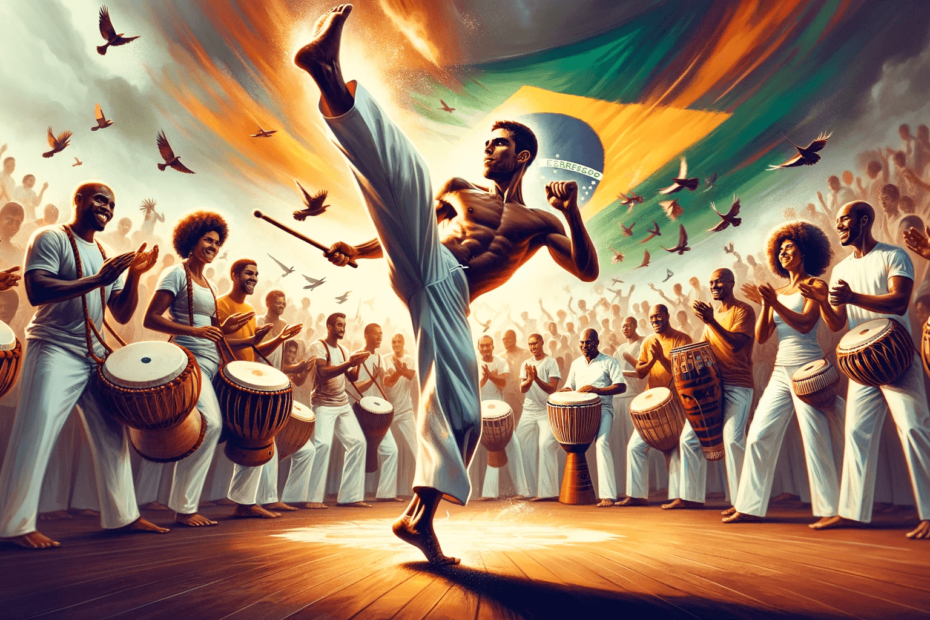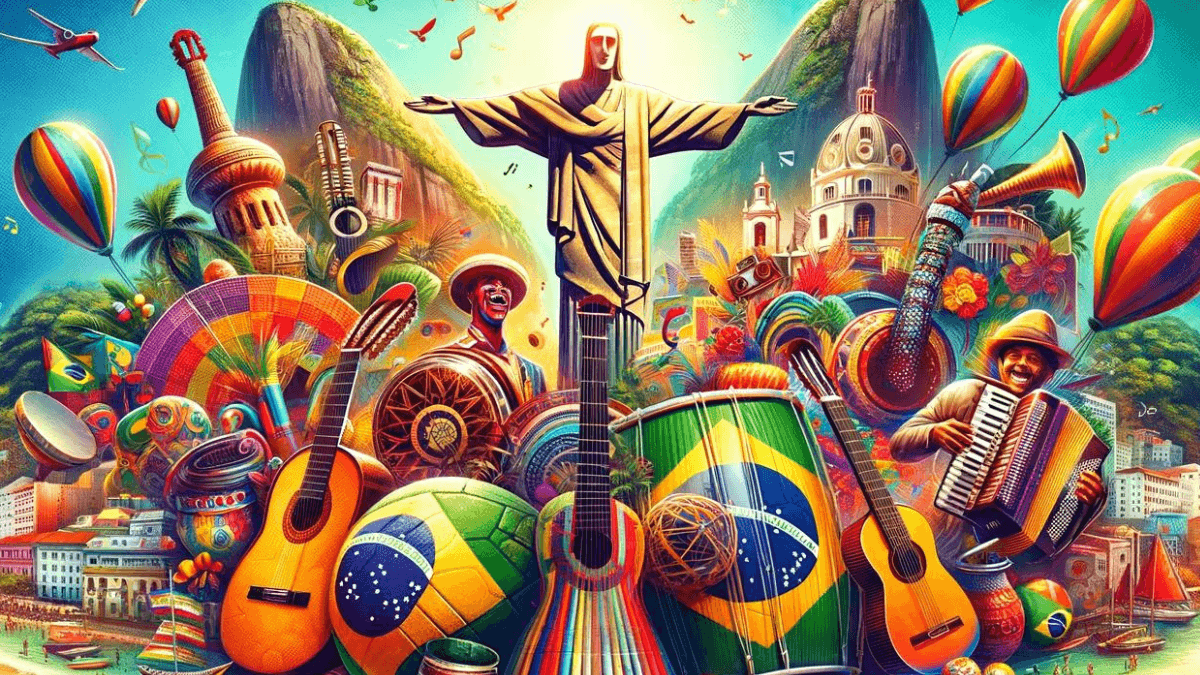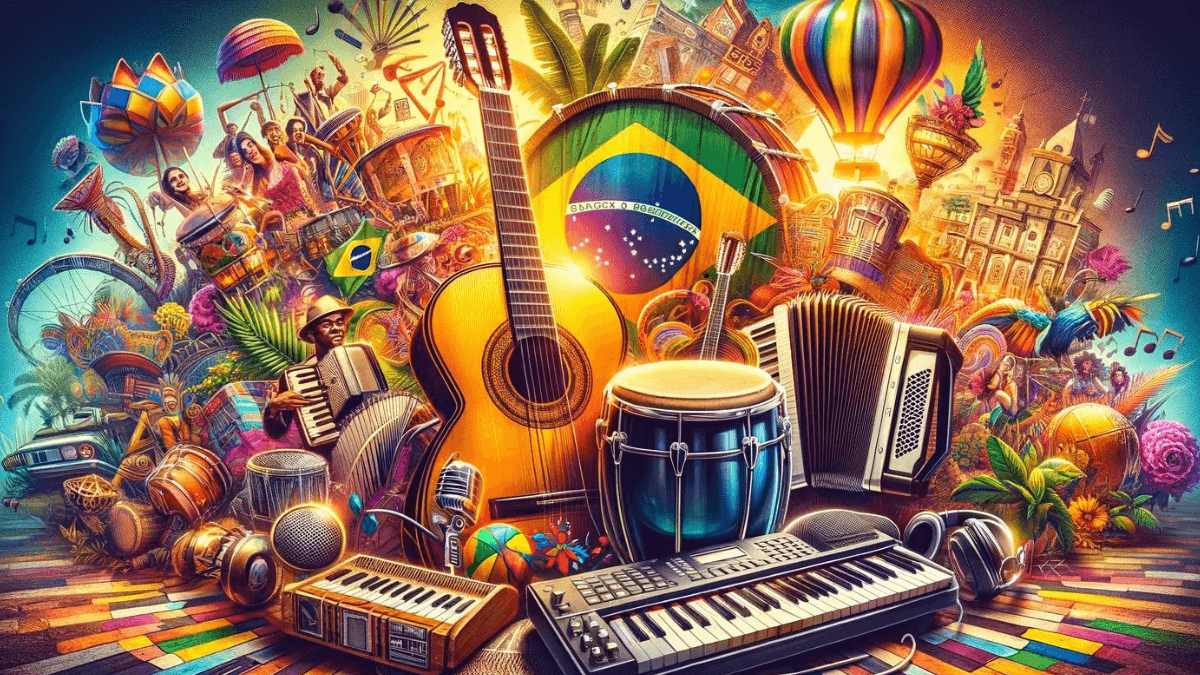Brazilian Capoeira weaves dance, fight, and music into a vibrant cultural tapestry. Dive into its world, where every movement tells a story.
Key Takeaways:
- Capoeira is a unique blend of martial arts, dance, and music, offering physical, mental, and cultural enrichment.
- Originating from African and Brazilian heritage, it’s a powerful expression of resistance and resilience.
- The practice includes diverse styles like Angola, Regional, and Contemporânea, each with unique characteristics.
- Music and instruments like the berimbau play a central role, guiding the rhythm and style of play.
- Learning Capoeira involves embracing its rich cultural heritage, understanding its history, and participating in its community.
Imagine this: the grace of a dancer, the agility of a fighter, all wrapped up in a musical extravaganza that’s as captivating to watch as it is to participate in.
This isn’t just martial arts; it’s a celebration of culture, a display of resistance, and a testament to the resilience of the human spirit.
Born from the depths of African and Brazilian heritage, Capoeira is a vivid tapestry woven with kicks, spins, and rhythmic moves, all set to the soul-stirring tunes of traditional instruments.
Welcome to the world of Brazilian Capoeira, where every movement and melody has a history, and every game tells a new tale.
What is Capoeira?
Capoeira is a unique fusion where martial arts meets dance, peppered with acrobatics, all driven by live music that dictates the pace and style of the game being played within the circle, known as the “roda.”
But to call Capoeira merely a martial art or a dance would be to oversimplify its essence. It’s a cultural expression that encompasses music, language (Portuguese), and a sense of community, all of which reflect the vibrancy and diversity of Brazilian culture itself.
Through Capoeira, practitioners (capoeiristas) connect with their history, express their creativity, and challenge their physical and mental limits, making it a truly holistic cultural practice.
Plan your trip to Brazil
- Find the cheapest flights
- Discover the best accommodation
- Explore this incredible country with the best experiences
- Stay connected at all times with an eSIM
History of Brazilian Capoeira
Capoeira is a tale of survival, resilience, and freedom. It all began in the sweltering heat of Brazil’s colonial plantations, where African slaves yearned for freedom.
They were far from home, but their spirits, oh, they remained unbroken. From this longing, Capoeira was born—a blend of dance, fight, and sheer artistry, cleverly disguised as a harmless dance to the unsuspecting eyes of their oppressors.
These African roots run deep, infusing Capoeira with rhythms, movements, and traditions that trace back to ancient African societies.
It was not just a martial art but a lifeline, a way to keep the spirit of freedom alive, a secret language of resistance among the enslaved.
As the years rolled on, Capoeira began to evolve. From the shadows of oppression, it moved to the streets, becoming a symbol of resistance and identity for Brazilians, especially those of African descent.
It wasn’t always smooth sailing, though. There were times when the authorities banned Capoeira, fearing its power as a tool of rebellion. But like the resilient Capoeiristas, it adapted, survived, and thrived.
Fast forward to Brazil’s bustling cities and beyond, Capoeira has transformed.
It’s now celebrated as a vibrant expression of Brazilian culture, recognized worldwide for its athletic and artistic beauty.
But let’s not forget, every swift move, every rhythmic beat in Capoeira, tells the story of a fight for freedom, a dance of resilience, and a deep, enduring connection to its African roots.
It’s a journey from the shackles of slavery to the global stage, marking the indomitable spirit of human creativity and survival.
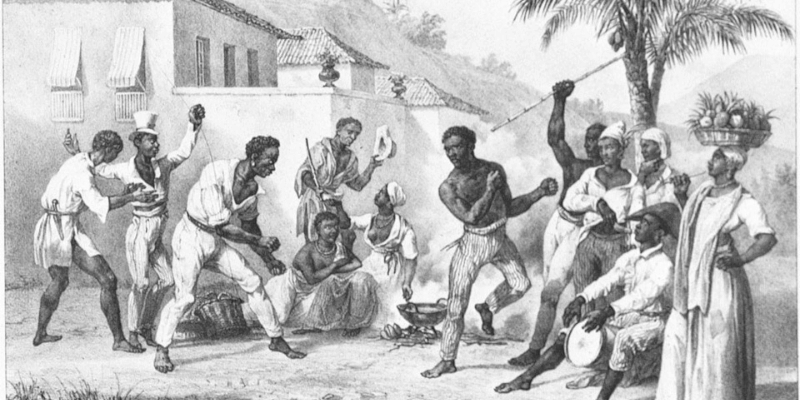
The Elements of Brazilian Capoeira
Capoeira is a symphony of physical prowess, musical rhythm, and cultural heritage. It weaves together fight, dance, and music, creating an art form that’s as enchanting as it is powerful. Let’s explore its core elements.
Fight
Diving into the heart of Capoeira, we find the “fight” – but not your run-of-the-mill brawl. This is poetry in motion, a dialogue of bodies, where each movement carries the weight of history and the grace of dance.
At its core, Capoeira is a martial art like no other, blending combat techniques with acrobatics, making it a spectacle of speed, agility, and strategy.
The techniques are a dazzling array of kicks, sweeps, dodges, and flips.
Each capoeirista (Capoeira practitioner) dances around the roda (the circle where Capoeira is played) with movements that can switch from a high-flying kick to a low, cunning dodge in the blink of an eye.
These movements are not just for show; they are steeped in tactical cunning, designed to outmaneuver opponents in a game of physical chess.
The “jogo” (game) is the very essence of Capoeira. It’s here, within the circle, that capoeiristas engage in a dialogue without words, a conversation through movement.
The jogo is about respect, strategy, and skill, where each player reads the other’s intentions and responds in kind, all while maintaining the flow and rhythm dictated by the music.
It’s a test of physical and mental agility, where the aim isn’t to harm but to outsmart, to dance on the edge of combat and camaraderie.
Music
Ah, the soul of Capoeira lies not just in the movement but in the music, the heartbeat that guides the dance, the fight, the game. It’s what makes Capoeira uniquely beautiful, a true celebration of life and culture.
Music: It’s the compass that sets the rhythm, pace, and style of the Capoeira game. Each beat, each note, tells the capoeiristas when to attack, when to retreat, and when to engage in playful trickery.
It’s a language of its own, speaking directly to the soul, compelling the body to move in ways that blur the lines between combat and dance.
Instruments: The berimbau leads this orchestra, its singular, haunting twang commanding the circle with an authority all its own. The atabaque, a type of drum, provides the heartbeat, while the pandeiro, similar to a tambourine, adds complexity and layers to the rhythm.
Together, they create a melody that transports the capoeiristas and spectators alike to a world where art meets athleticism, and history dances with the present.
Songs: Now, these are not just any songs. They are the oral history of Capoeira, telling tales of legendary masters, battles fought, and wisdom gained.
Each song has a purpose, whether to inspire, to teach, to challenge, or to praise. Learning these songs is as crucial as mastering the moves because they carry the essence, the very spirit of Capoeira.
Through them, we connect with our past, we share our stories, and we pass down the legacy of Capoeira to future generations.
So, when you step into a roda, the circle where Capoeira comes alive, you’re not just entering a space to witness a martial art.
You’re stepping into a living, breathing expression of Brazilian culture, where every beat, every melody, and every lyric is a thread in the vibrant tapestry that is Capoeira.
Also See | Meanings of Samba: Culture, Identity, and History in Brazil
Styles of Capoeira
Capoeira, my friends, isn’t a one-size-fits-all kind of deal. It’s as diverse as Brazil itself, evolving into styles that reflect different philosophies, techniques, and eras.
Let’s groove into the main styles that have shaped Capoeira’s legacy: Capoeira Angola, Capoeira Regional, and Capoeira Contemporânea.
Capoeira Angola
This is the traditional form, the root from which all Capoeira springs. It’s a slower, more ritualistic style that emphasizes cunning, strategy, and the heritage of Capoeira.
Think of it as a game of chess with your body, where every move is deliberate and steeped in history. Capoeira Angola is a nod to the past, a tribute to the ancestors who created Capoeira as an act of resistance and liberation.
Capoeira Regional
Enter Mestre Bimba in the early 20th century, who felt Capoeira was losing its edge. He developed Capoeira Regional, a faster, more athletic style that incorporated new movements and training methods.
Capoeira Regional was about revitalizing the art, making it more accepted by mainstream society, and indeed, it played a huge role in Capoeira being recognized as a national sport of Brazil.
Capoeira Contemporânea
As the name suggests, this is the contemporary face of Capoeira, blending elements from both Angola and Regional styles.
It’s a fusion, adaptable and fluid, reflecting the global spread of Capoeira. Capoeira Contemporânea is about innovation, exploring new movements while respecting the roots, making Capoeira accessible to a worldwide audience.
Capoeira’s Influence on Culture
Capoeira is not just a martial art; it’s a cultural phenomenon that weaves through the fabric of Brazilian society, leaving vibrant threads of influence in its wake.
A Symbol of Resistance
From its inception, Capoeira was a tool of defiance against colonial oppression and slavery. It embodies the spirit of resistance, a silent yet powerful protest embedded within the rhythms and moves.
This spirit is deeply ingrained in Brazilian culture, reminding us of the strength and resilience of our ancestors.
Cultural Integration
Capoeira has played a significant role in the integration of African cultural elements into the broader Brazilian culture. It’s a melting pot of traditions, languages, and beliefs.
The music, the instruments, and the techniques are all testament to this rich cultural fusion, making Capoeira a beacon of Brazil’s diverse heritage.
Social Changes
Throughout its history, Capoeira has mirrored Brazil’s social changes. Once banned and criminalized, its acceptance and celebration as a national treasure illustrate Brazil’s journey towards recognizing and valuing its African roots and cultural diversity.
Capoeira has transitioned from being an art of the marginalized to a celebrated symbol of Brazilian identity and pride.
Global Ambassador
Capoeira has transcended national boundaries to become a global ambassador of Brazilian culture. Through international Capoeira schools and performances, it shares the story of Brazil with the world, spreading its messages of unity, strength, and resilience.
This global reach has, in turn, enriched Capoeira itself, incorporating new influences while spreading Brazilian culture worldwide.
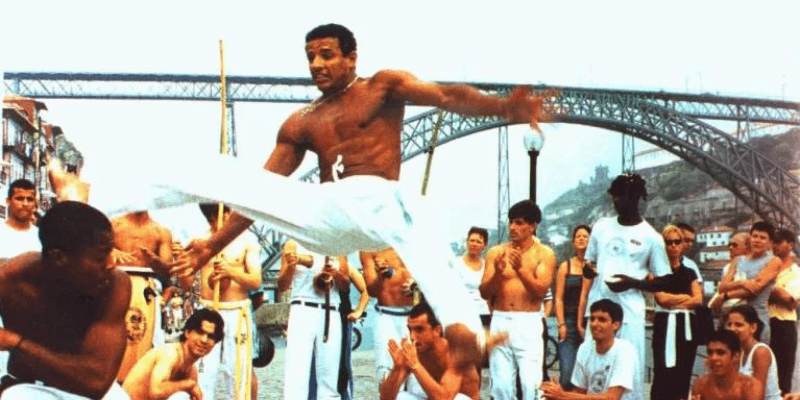
Influence on Arts and Media
Capoeira’s dynamic movements and captivating rhythms have influenced various aspects of Brazilian arts, from dance and music to cinema and literature.
It’s a source of inspiration for artists, who see in Capoeira a reflection of Brazil’s soul—a blend of beauty, struggle, and jubilation.
Capoeira pronunciations
Let’s get you speaking with the rhythm and flair of a Brazilian!
Capoeira
- How to say it: kah-poo-eyh-rah
- What it means: Our beloved martial art that combines elements of dance, acrobatics, and music.
Roda
- How to say it: hoh-dah
- What it means: The circle formed by capoeiristas where the game of Capoeira takes place.
Berimbau
- How to say it: beh-rin-bow (like “bow” in bow and arrow)
- What it means: A musical bow that leads the rhythm of the Capoeira game.
Atabaque
- How to say it: ah-tah-bah-keh
- What it means: A tall, wooden drum used in Capoeira music.
Pandeiro
- How to say it: pan-day-roh
- What it means: A type of tambourine that adds to the Capoeira beat.
Ginga
- How to say it: jeen-gah
- What it means: The fundamental footwork of Capoeira, a swinging motion that keeps capoeiristas ready to move.
Mestre
- How to say it: mesh-treh
- What it means: A master of Capoeira, someone who has achieved a high level of skill and knowledge in the art.
Axé
- How to say it: ah-shay
- What it means: A term that conveys energy, life force, or blessing. It’s often used to express good vibes or spiritual strength in Capoeira.
Capoeirista
- How to say it: kah-poo-eyh-ree-stah
- What it means: A practitioner of Capoeira.
Remember, pronunciation can vary a bit with different accents and regions in Brazil, but with these basics, you’re well on your way to chatting up a storm about Capoeira.
Embrace the mistakes, keep practicing, and most importantly, have fun with it! Capoeira is all about the joy of movement, music, and community. Axé!
Also See | Brazil Carnival: A Vibrant Mosaic of Cultural Celebrations
Is Capoeira Useful?
So, is Capoeira useful? Sem dúvida (Without a doubt)! It’s a holistic workout that nurtures the body, sharpens the mind, and enriches the soul, proving that the benefits of this beautiful Brazilian art form extend well beyond the roda.
Let’s break down why Capoeira isn’t just cool to watch or fun to do, but genuinely useful in so many aspects of life.
Physical Benefits
- Strength: Capoeira is a powerhouse of an exercise. From the ginga to the au, every move demands and builds strength in the legs, arms, and core. It’s not just about looking good; it’s about being strong.
- Flexibility: Those high kicks and deep dodges? They aren’t just for show. Capoeira naturally enhances your flexibility, making those impressive moves easier over time and keeping your body young and nimble.
- Agility: The quick movements, swift dodges, and acrobatic flips sharpen your agility. Capoeira teaches you to move with precision and grace, making it a perfect way to improve your physical coordination and reaction time.
Mental Benefits
- Focus: In the roda, losing focus means missing the rhythm or a coming kick. Capoeira trains your mind to concentrate on multiple elements, from the music to your opponent’s next move.
- Strategy: It’s often called a game for a reason. Deciding when to attack, when to defend, and when to trick your opponent requires quick thinking and strategic planning, honing your mental agility as much as your physical.
- Resilience: Every capoeirista learns to fall and get back up. It teaches resilience, both mentally and physically, encouraging you to push through challenges, in and out of the roda.
Social and Cultural Benefits
- Community: Capoeira is not a solitary journey. It’s practiced in a group, encouraging social connections. You’ll meet people from all walks of life, each sharing the same passion for Capoeira.
- Cultural Awareness: Through songs, movements, and history, Capoeira offers a profound insight into Brazilian culture, and often, the cultures of the world. It fosters a deep appreciation and understanding of cultural diversity.
- Confidence and Expression: This art form provides a unique outlet for personal expression, allowing individuals to communicate in ways beyond words. The confidence gained through mastering movements and engaging in the roda can translate into everyday life, empowering personal and professional interactions.
How to learn Brazilian Capoeira?
So, you’ve been bitten by the Capoeira bug, huh? Fantástico!
Capoeira is not just about learning to move your body; it’s about embracing a whole new way of life. But where do you start?
Let me guide you through the steps to immerse yourself in the world of Brazilian Capoeira.
Finding a Capoeira School or Group
Local Search: The first step is to look for a Capoeira school or group near you. Many cities around the world have Brazilian cultural centers or martial arts schools that offer Capoeira classes.
A quick online search or a scroll through social media platforms can point you in the right direction.
Try Different Styles: Remember, there are different styles of Capoeira (Angola, Regional, Contemporânea), and each school or group might have its own focus. Try a few classes in different places to see which style resonates with you.
Attend Workshops and Events: Capoeira workshops and events are great places to learn, observe, and ask questions. Plus, they’re a fantastic way to meet capoeiristas and become a part of the community.
Tips for Beginners
Stay Patient and Open: Capoeira is a complex art form that takes time to learn. Don’t get discouraged by the initial challenges. Stay patient and keep an open mind.
Practice Regularly: Like any skill, Capoeira requires regular practice. Try to attend classes consistently and practice what you’ve learned at home.
Embrace the Music: Music is at the heart of Capoeira. Listen to Capoeira music, learn the instruments, and try to understand the songs. It will deepen your connection to the art and improve your rhythm in the roda.
Learn Portuguese: Understanding basic Portuguese will enhance your Capoeira experience. It will help you grasp the songs’ meanings, communicate better with your mestre (teacher), and enrich your understanding of Capoeira’s cultural nuances.
The Role of the Capoeira Community and Culture in Learning
Support and Inspiration: The Capoeira community is incredibly welcoming and supportive. Fellow capoeiristas can provide advice, encouragement, and inspiration.
Cultural Immersion: Capoeira is more than just physical movement; it’s a cultural expression. Participating in cultural events, celebrations, and ceremonies related to Capoeira will deepen your appreciation and understanding of this art form.
Learning from Others: In Capoeira, everyone is a teacher, and everyone is a student. Learning from the experiences and techniques of others in the community is invaluable. The roda is a place of mutual respect and learning, where knowledge is shared freely.
References/Further Reading
To deepen your understanding and appreciation of Brazilian Capoeira, consider exploring the following resources:
- Books:
- “Capoeira: A Brazilian Art Form: History, Philosophy, and Practice” by Bira Almeida
- “The Hidden History of Capoeira: A Collision of Cultures in the Brazilian Battle Dance” by Maya Talmon-Chvaicer
- Documentaries:
- “Capoeira: Fly Away Beetle” offers a deep dive into the history and practice of Capoeira.
Capoeira’s Heartbeat: A Global Call to Dance and Unity
In the heartbeats of Brazil pulses the vibrant rhythm of Capoeira, a dazzling blend of martial arts, dance, and music. It’s more than just a cultural artifact; it’s a living expression of resilience, unity, and freedom.
Capoeira embodies the spirit of Brazil, weaving together the threads of its diverse heritage and reflecting the strength of its people.
Its global spread is a testament to its universal appeal, inviting everyone, regardless of background, to partake in its rich traditions.
I encourage you to dive into the world of Capoeira, to let its rhythms move you and its history inspire you.
Whether you’re looking for a new physical challenge, a deeper cultural connection, or simply the joy of movement and music, Capoeira offers it all.
And what better way to truly experience its magic than by traveling to Brazil, where every kick, every song, and every roda tells a story?
Embrace the journey, explore Capoeira, and discover the pulsating heart of Brazil. Vamos lá!
Did you like our content, do you want to get to know our country?! Discover the best experiences to live in Brazil!
